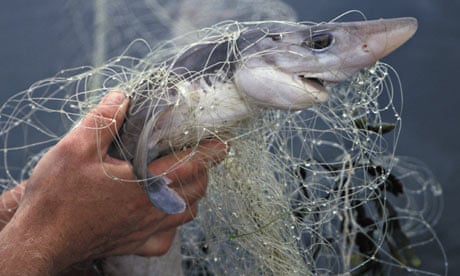More than a quarter of sharks and rays in the north-east Atlantic face extinction from overfishing, conservationists warned today.
A "red list" report from the International Union for Conservation of Nature (IUCN) found that 26% of all sharks, rays and related species in the regional waters are threatened with extinction. Seven per cent are classed as critically endangered, while a fifth are regarded as "near-threatened".
The total number of at-risk species may well be higher because scientists lack of sufficient information to assess the populations of more than a quarter (27%) of them, the report adds. Many are slow-breeding fish that are especially vulnerable to fisheries.
Two species of shark that are highly prized for their meat, the spiny dogfish (rock salmon) and porbeagle, are critically endangered. They are among the few species that are subject to EU fishing restrictions, although these quotas are well above the zero-catch levels proposed by scientists at the International Council for Exploration of the Sea (Ices).
Angel sharks and common skates are also critically endangered in the north-east Atlantic, prompting Ices scientists to call for greater restrictions on fisheries that target them or land them as bycatch. The basking shark, the world's second largest fish, was listed as vulnerable.
Sonja Fordham, policy director at the Shark Alliance, and co-author of the report said: "The north Atlantic is one of the most overfished regions in the world and yet only four species of sharks and rays are protected. This is a clear consequence of overfishing, whether these species are targeted or taken as bycatch."
Another species listed as critically endangered is the deep-water gulper shark, sought for its rich liver oil, which is used by the cosmetics industry. In 2005, Ices urged the EU to effectively ban deepwater shark fishing, but current quotas allow more than 800 tonnes to be taken next year.
The percentage of sharks and rays in the north-east Atlantic region classified as threatened is higher than the figure for species globally (18%), the IUCN found. It said the decline in numbers was due to the activity of fishing nations such as Spain, Portugal, France and Britain.
"North-east Atlantic populations of these vulnerable species are in serious trouble, more so than in many other parts of the world," said Claudine Gibson, former programme officer for the IUCN's shark specialist group and lead author of the report.
"Most sharks and rays are exceptionally vulnerable to overfishing because of their tendency to grow slowly, mature late, and produce few young. Those at greatest risk of extinction in the northeast Atlantic include heavily fished large sharks and rays like porbeagle and common skate, as well as commercially valuable deepwater sharks and spiny dogfish."
Marine conservationists urged EU fisheries ministers, who are due to agree fishing quotas in December, to impose tighter restrictions in line with scientific advice.
"Country officials should heed the dire warnings of this report and act to protect threatened sharks and rays at national, regional and international levels. Such action is immediately possible and absolutely necessary to change the current course toward extincction of these remarkable ocean animals," said Fordham.
